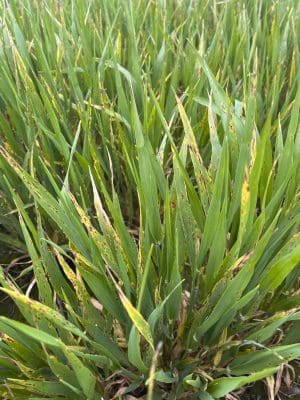BARLEY growers on South Australia’s Yorke Peninsula should review their disease-management practices after samples of net form net blotch (NFNB) collected from local paddocks showed resistance to three widely used fungicide groups.

Uncontrolled NFNB disease in a barley crop at Warooka on Yorke Peninsula after treatment with all three registered fungicide modes of action. Photo: Tara Garrard, SARDI
NFNB is a fungal disease which can reduce yield and grain quality in barley, an important crop for Australian growers.
As part of a Grains Research and Development Corporation investment, researchers analysed infected plant samples from three separate paddocks at Corny Point, Warooka and Paskeville on YP, and from a paddock at Streatham in Victoria’s Western District.
The samples contained fungal isolates with genetic mutations associated with resistance or reduced sensitivity to the three fungicide groups – namely groups 3, 7 and 11 – currently available for controlling NFNB.
Importantly, the disease on YP was not controlled by fungicide applications; this means all three fungicide groups currently available to YP barley growers are compromised for controlling NFNB.
Disease control in Streatham is not currently compromised, but use of fungicides from these groups may encourage the selection and spread of the triple-resistant fungal disease population in paddocks where it is present.
Furthermore, any combination of fungicides may fail to adequately control the disease in barley paddocks where the triple-resistant fungus is present at high frequencies.
GRDC crop protection manager south Ruth Peek said growers can help protect barley yields for the coming season by eliminating all “green bridge” volunteer barley, and consult with an agronomist about fungicide options for their specific local area.
“Growers should also prioritise planning more non-barley rotations and choosing barley cultivars with improved net form net blotch resistance for subsequent years,” Ms Peek said.
Analysis of the samples was coordinated by Curtin University-based Fran Lopez-Ruiz, project lead for the Australian Fungicide Resistance Extension Network.
Dr Lopez-Ruiz agrees the best approach is for growers to shift to newer barley cultivars with improved genetic resistance to NFNB, and to adopt agronomic disease-management practices including rolling or grazing barley stubble and planting non-barley crop rotations.
Growers wanting to limit the chances of fungicide resistance developing can follow AFREN’s Fungicide Resistance Five principles:
- Avoid susceptible crop varieties;
- Rotate crops;
- Use non-chemical control methods;
- Spray strategically and only if necessary; and,
- Rotate and mix fungicides.
Dr Lopez-Ruiz said agronomy can be used to minimise disease pressure and reduce reliance on fungicides during the growing season.
“This reduces fungicide exposures that could encourage the development and spread of resistance,” Dr Lopez-Ruiz said.
“Even using fungicides to control other diseases of barley can select resistance in any net form net blotch pathogens that are also present.
“The only way to maximise the lifespan of existing fungicides is to rely on non-fungicide strategies to minimise disease.
Dr Lopez-Ruiz said Group 3 and 7 fungicides have been compromised in NFNB for about five years.
“We have also been concerned about a mutation for resistance to Group 11 fungicides that was first detected in trials on the Yorke Peninsula in 2022.
“We weren’t surprised to find this Group 11 resistance when we tested the 2024 samples, but then we found mutations for Group 3 and 7 resistance in the same samples.
“We believe the observed failure to control disease of successive single and mixed fungicide applications, from multiple fungicide groups, are due to the combined triple-resistance mutations.”
Wind and splash dispersal can rapidly spread fungal spores containing resistance mutations.
Typically, spores will travel short distances within the crop but can also be blown into neighbouring crops.
Crucially, researchers consider it likely that the triple mutants are already present in surrounding paddocks.
AFREN is a GRDC investment to promote best practice management strategies for reducing the impact and emergence of fungicide resistance.
Source: GRDC

Eliminating green bridge will make very little difference as the pathogen is principally stubble borne.